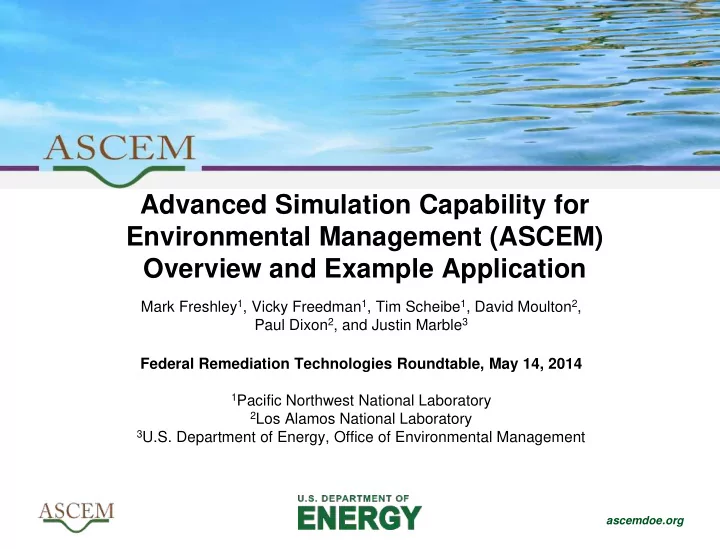

Advanced Simulation Capability for Environmental Management (ASCEM) Overview and Example Application Mark Freshley 1 , Vicky Freedman 1 , Tim Scheibe 1 , David Moulton 2 , Paul Dixon 2 , and Justin Marble 3 Federal Remediation Technologies Roundtable, May 14, 2014 1 Pacific Northwest National Laboratory 2 Los Alamos National Laboratory 3 U.S. Department of Energy, Office of Environmental Management ascemdoe.org
What is ASCEM? Advanced Simulation Capability for Environmental Management Modeling toolset currently under development for understanding and predicting subsurface contaminant fate and transport Organized into three thrust areas High Performance Computing – open-source, high performance simulator (Amanzi) Platform – tools that facilitate model setup and simulation execution (Akuna) Applications – demonstrate the tools through applications to real sites Completed initial user release of toolset ascemdoe.org
User Environment ascemdoe.org
Application to Hanford BC Cribs Former plutonium production site Waste disposed from 1956 to 1958 to 6 cribs Funnel-shaped with sloping sides (~3 x 3 m wide) Located a few meters bgs Thick vadose zone (~107 m) Primary contaminant of concern utsronmlkihgfedcbaUTSRQHF 99 Tc Traditional remediation technologies are ineffective Evaluate uncertainty impact on remediation (Rucker and Fink 2007) ascemdoe.org
Problem Description Cribs Boundary Conditions > 10 million gallons liquid waste released at 6 cribs • 1956 – 1958 • 99 Tc primary contaminant • Source concentrations ~10 6 pCi/L Recharge at surface Water table boundary at the bottom of the domain 320 m x 280 m x 107 m (~455K grid blocks) Executed simulation from 0 – 2008 0 – 1956 period to attain steady state flow field Borehole C 1956 – 2008 transient Water Table Borehole A ascemdoe.org
Model Setup ascemdoe.org
Major Stratigraphy ascemdoe.org
Incorporation of Heterogeneity Generated 100 realizations of three-dimensional lithofacies distributions using geostatistical model Lithofacies: Clean sand Identified by k-means cluster Sandy gravel analysis of 232 Th and 40 K Muddy sand data (spectral gamma log data) Three lithofacies identified, log data from 5 wells ascemdoe.org
Geologic Realizations Selected 10 realizations for demonstration Layering is the same, but small- scale variability in hetereogeneities captured ascemdoe.org
Property Assignments and Boundary Conditions Hydraulic Property Input Boundary Condition Input ascemdoe.org
Parameter Estimation Permeability and porosity estimation Moisture content and 99 Tc measured in 2008 at Boreholes A & C Data obtained from database, accessed through web interface, and exported to Akuna ascemdoe.org
Parameter Estimation Parameter Estimates ascemdoe.org
Simulation 1956 – 2008 ascemdoe.org
Uncertainty Quantification Varied recharge rate for 100 simulations for 2012 – 3000 Rates represent management actions (1 – 75 mm/yr) Soil desiccation Surface barriers No-action Soil flushing Metrics Peak concentration and arrival time at water table Time at which a threshold concentration is exceeded utsronmlkihgfedcbaUTSRQHF Launched on 9600 processor Screenshot from UQ Toolset: cores, 96 per simulation Histogram of Recharge Rates ascemdoe.org
Uncertainty Quantification a) Time to peak occurs within 200 years, small variation with recharge rate a) Mean and 95% confidence intervals for 99 Tc breakthrough utsronmlkihgfedcbaUTSRQHF at boreholes A and C b) Histogram of time to reach peak concentration b) ascemdoe.org
Uncertainty Quantification Compare breakthrough curves for one conceptual model realization to all 10 Confidence intervals are wider when 10 realizations of the conceptual model are considered Upper bound is ~85% higher at Borehole A for all ten models than for GR01 Mean and 95% confidence intervals for the 99 Tc breakthrough curve at Boreholes A and C for single and multiple geologic realizations ascemdoe.org
Conclusions ASCEM facilitates model setup, execution, analysis, and visualization High performance computing enables multiple realizations of complex model through reduction in computational time Simulations of BC Cribs provides insight on controlling processes and properties for 99 Tc transport in the subsurface Baseline conditions for “no action” alternative Variation in recharge rate from soil desiccation and surface barriers Variability in conceptual models impacted the magnitude of peak concentrations, but had minor impact on arrival times ascemdoe.org
Thank You! Contacts: Mark Freshley, Pacific Northwest National Laboratory Site Applications (mark.freshley@pnnl.gov) Paul Dixon, Los Alamos National Laboratory ASCEM Multi-Laboratory Program Manager (p_dixon@lanl.gov) Justin Marble, DOE EM ASCEM Federal Program Manager (justin.marble@em.doe.gov) http://ascemdoe.org/ ascemdoe.org
Recommend
More recommend